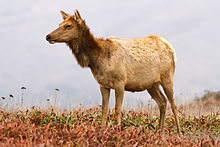Tule elk
| Tule elk | ||||||||||||
|---|---|---|---|---|---|---|---|---|---|---|---|---|

Bull of the Tule elk |
||||||||||||
| Systematics | ||||||||||||
|
||||||||||||
| Scientific name | ||||||||||||
| Cervus canadensis nannodes | ||||||||||||
| Merriam , 1905 |

The Tule elk ( Cervus canadensis nannodes ) is a subspecies of the elk from the deer family (Cervidae) that occurs only in California . The name of the Tule elk is derived from Schoenoplectus acutus , a species of pond rush native to North America , which is known in English under the common name "Tule" [ ˈtuːliː ] and is part of the animal's diet.
features
Among the elk in North America, the tule elk is the smallest subspecies. Bulls reach an average body weight of around 251 kilograms, cows a weight of around 186 kilograms. Cows are fully grown by the age of two, while bulls continue to grow until the end of their lives, with the size and shape of their antlers changing and the size of their skull increasing.
From its close relatives, the Rocky Mountain elk ( Cervus canadensis nelsoni ) and the Roosevelt elk ( Cervus canadensis roosvelti ), the Tule elk differs in its smaller body size and its lighter, straw-colored fur in autumn and winter.
Way of life
With the Tule elk, the cows live in herds , while the larger deer form separate groups for much of the year. With the start of the rut , these groups break up and the males join the herds of cows, with fights between the top deer and younger, rival deer.
In spring and early summer, annual herbaceous plants such as Eriogonum fasciculatum or Layia platyglossa play an important role in the food spectrum of the Tule elk . Annual and perenne grasses such as Stipa speciosa or Elymus elymoides are part of the animal's diet throughout the year. Studies from the 1960s found that the proportion of grass in the Tule elk's diet could rise to nearly 50% in October.
Existence and distribution

Before the arrival of the European settlers, up to 500,000 Tule elk are said to have lived in California. In the course of the California gold rush , the population of the animals was drastically reduced through hunting and habitat restriction, so that at the beginning of the 1870s it was initially assumed that the subspecies was extinct. Although there are different information about the exact numbers, based on genetic analyzes it is now assumed that at least two male specimens and one female specimen (or vice versa) survived in the southern San Joaquin Valley in 1874 . After being rediscovered by a rancher, the animals were specifically reproduced on a private initiative and are considered the origin of today's population. When the Tule wapiti was officially placed under protection in 1971, the population had grown to 500 specimens. In 1998, the total wildlife population was estimated at 3,000 individuals. In 2014 the number was given as 4200 in 22 herds.
The current distribution area of the Tule elk stretches mainly along the California Pacific coast from Elk Creek in Mendocino County in the north to La Panza in San Luis Obispo County in the south, with a herd further east in Owens Park in Inyo County (map). These are subpopulations that are independent of one another and show no inbreeding depression despite the genetic bottleneck that arose in the 1870s .
literature
- Dale R. McCullough: The Tule Elk. Its History, Behavior, and Ecology , Berkeley [et al. a.] 1971, ISBN 0-520-01921-0 .
- Jack Ward Thomas / Dale E. Toweill (Eds.): Elk of North America. Ecology and Management , Harrisburg, Pa. 1982, ISBN 0-8117-0571-4 .
Individual evidence
- ↑ a b Dale R. McCullough, The Tule Elk. Its History, Behavior, and Ecology , Berkeley [et al. a.] 1971, p. 6.
- ^ McCullough, The Tule Elk , p. 4.
- ^ McCullough, The Tule Elk , p. 52.
- ↑ On this and the following cf. Jack R. Nelson / Thomas A. Leege, Nutritional Requirements and Food Habits , Section "Tule Elk", in: Jack Ward Thomas / Dale E. Toweill (Eds.), Elk of North America. Ecology and Management, Harrisburg, Pa. 1982, pp. 357-359.
- ↑ CM Ferrel, Miscellaneous food habit studies , Sacramento 1962 and 1963, cited here from Nelson / Leege, Nutritional Requirements and Food Habits, p. 359.
- ↑ Dale R. McCullough, From Bottleneck to Metapopulation: Recovery of the Tule Elk in California , in: Metapopulations and Wildlife Conservation, ed. By Dale R. McCullough, pp. 375–403, here p. 385, Figure 16.3
- ↑ a b Kim Linse, Tule Elk - The Return of a Species , 1998 National Park Service brochure .
- ↑ EP Meredith [u. a.]. Microsatellite analysis of three subspecies of elk (cervus elaphus) in California , in: Journal of Mammalogy 88, 3 (2007), pp. 801-808, here p. 806, doi : 10.1644 / 06-MAMM-A-014R.1
- ↑ Meredith [u. a.], Microsatellite analysis , p. 801.
- ↑ Baynature.org: Tule Elk Relocated As Numbers Rebound , May 7, 2014
- ^ McCullough, From Bottleneck to Metapopulation, pp. 385f.